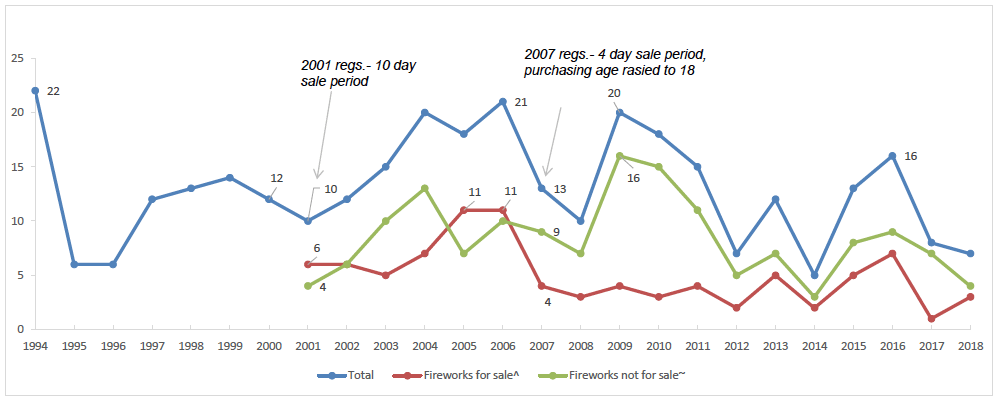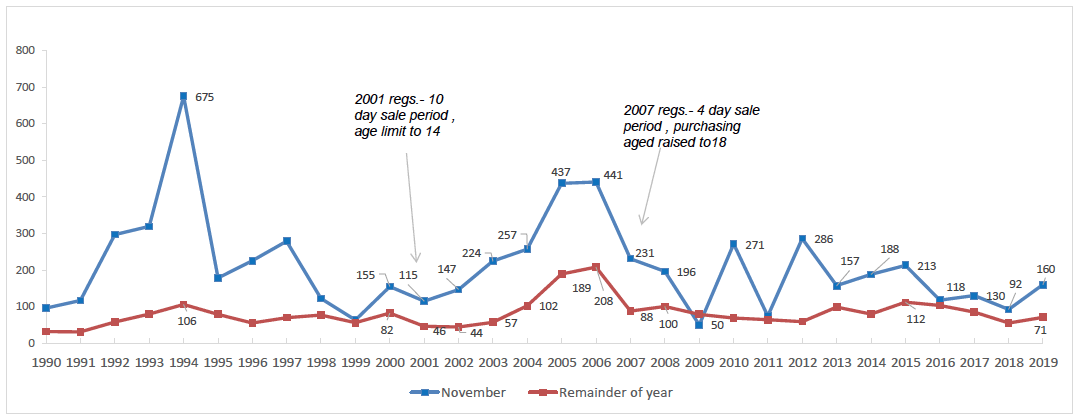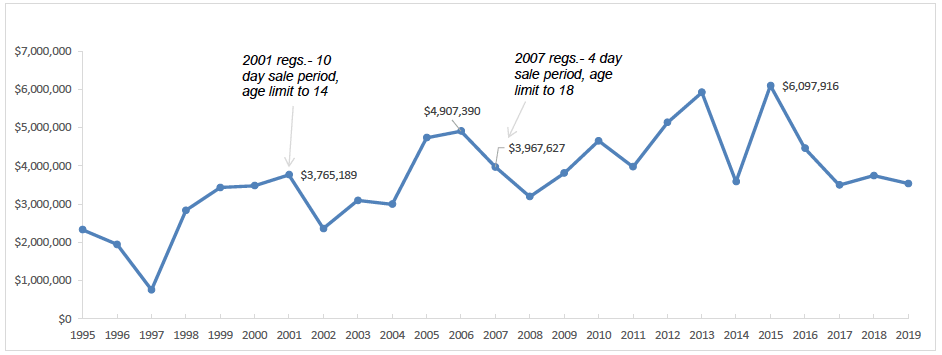Fireworks regulations - impact: case studies
This paper consists of seven case studies, each one aligned to one or more of the legislative options being considered by the Firework Review Group.
New Zealand
Main points
- There is no increasing or decreasing trend in the total number of people being discharged from hospital over the course of the whole year for injuries caused by fireworks following the introduction of regulations.
- The number of people discharged from hospital during the permitted sales window has been consistently lower since 2007 when the sales period was reduced to four days and the legal age for purchasing raised to 18. However, this could partly reflect the fact that since 2007 there are fewer days in which discharges can be recorded as occurring during the sales window, rather than the effectiveness of the regulations per se.
- Evidence shows that a decline in the number of firework-related incidents attended by the Fire and Emergency Service throughout November coincided with the enactment of regulations in 2001 and 2007 (sales window, legal age raised). However, in both instances it would appear that any 'effect' was not fully sustained over the longer term.
- The value (NZD $) of fireworks imports declined markedly in 2007 and 2008 before generally increasing and peaking in 2015.
Current fireworks regulations
- Consumer fireworks can only be sold on the four days up to and including the 05 November
- Legal age of purchase is 18
- The explosive content of some consumer fireworks is decreased
- Individual sale of sparklers is banned, they must be sold as part of a pack containing other fireworks
- Aligned legislative options: H
Policy background
In 1994 and 1996 the New Zealand Parliament debated the question of banning the public sale of all fireworks. On both occasions it was decided that the irresponsible use of fireworks by a few could not justify depriving families of the enjoyment of fireworks through a total ban. In addition, firecrackers and skyrockets were banned in 1994. To address the harm caused by those who use fireworks irresponsibly, regulations were introduced in 2001 that:
- limited the total amount of explosive material allowed in any one firework, and the design and nature of fireworks acceptable for use by the public
- limited the period for which fireworks can be sold to the ten days prior to Guy Fawkes Night
- limited the sale to persons aged 14 years and over
In 2004 the Minister for the Environment called for research into the sale of fireworks by retailers and for solutions that would prevent fireworks being misused. The investigation was the result of increasing numbers of people, animals and property being harmed by fireworks[58]. In 2006 a range of regulatory and non-regulatory options for retail fireworks was presented to Cabinet by the Minister for the Environment. Non-regulatory options including awareness campaigns were pursued for the 2006 firework season, with officials directed to undertake further analysis of possible regulatory options for 2007.
The 2006 fireworks season resulted in the highest number of firework-related call outs by the fire service since figures began in 1996- 1,729 call outs, 98 more than in 2005. The police also recorded an increase in call outs in 2006, up by 626 on 2005 to 1,815. In 2006, 1,763 tonnes of fireworks were imported into New Zealand, continuing the trend of increasing volume of firework imports (although the rate of growth had slowed compared to previous years).
A number of regulatory options were developed, with the intention of improving the management of the retail sale of fireworks and reducing the potential for their misuse. The options were balanced against the desire for families to continue to enjoy Guy Fawkes celebrations. Following an appraisal of the options and stakeholder engagement, the following relevant restrictions were introduced:
- legal age limit to purchase fireworks raised from 14 to 18 years
- the sale period for consumer fireworks reduced from 10 to the 4 days up to and including 05 November
- the individual sale of sparklers prohibited, they must be sold in packs with other fireworks
The above changes were enacted through 2007 amendments to the Hazardous Substances (Fireworks) Regulations 2001.
Impact of regulations: injuries
The Injury Prevention Research Unit at the University of Otago provided time series data on the number of discharges from public hospitals with a principal diagnosis of injury caused by fireworks[59]. The annual figures are presented in Graph 9. Alongside the total number of injuries, the data from 2001 onwards is disaggregated into injuries occurring during the permitted fireworks sales period and those which happened out-with this time.
The total number peaked in 1994 when 22 people were discharged following a firework injury, since then there has been no distinguishable increasing or decreasing trend. Generally speaking, since 2001 the number occurring out-with the sales period has followed a similar pattern to the total number of discharges.
Since 2007 the number of discharges occurring whilst fireworks are not for sale has been higher than the number happening during the sales window, but the numbers are low for both. This could point to issues around illegal fireworks but it could also reflect the fact that the period fireworks are not for sale covers a much longer time (355 days from 2001-2006, 361 days from 2007-2018). The number of discharges occurring out-with the sales period increased for three consecutive years following the introduction of initial sales window in 2001.
The number of discharges happening whilst fireworks are for sale peaked at 11 in both 2005 and 2006, and subsequently declined sharply in 2007 following the reduction of the sales window to four days and raising the legal age for purchasing to 18. The number has been consistently lower since the enactment of these regulations. However, the fact that there is no clear trend in the total number of discharges would suggest that the change during the sales period could partly reflect the fact that since 2007 there are fewer days in which discharges can be recorded as occurring during the sales window, rather than the effectiveness of the regulations per se.

* Excludes day patients, readmission for the same incident and where there was not a primary diagnosis of injury. Year concerns year of discharge.
^ 2001 to 2006- Injury occurred between 27 October and 05 November inclusive. 2007 to 2018- Injury occurred between 02 and 05 November inclusive.
Source: Injury Prevention Research Unit, University of Otago
Impact of regulations: crime
The only available fireworks-related crime data concerns the offence of 'set fireworks off in public place'[60]. The data for police recorded and resolved offences from 1994 to 2014 is presented in Table 11. A recorded offence concerns those that are reported to the police, whilst a resolved offence is a recorded offence where an offender is identified and dealt with (e.g. prosecuted, warned, cautioned etc.). The data shows that since the baseline year of 1994, there has been no clear pattern in the number of recorded and resolved offences, making it difficult to decipher if there is any relationship between offences and the regulations.
| 1994 | 1995 | 1996 | 1997 | 1998 | 1999 | 2000 | 2001 | 2002 | 2003 | 2004 | 2005 | 2006 | 2007 | 2008 | 2009 | 2010 | 2011 | 2012 | 2013 | 2014 | |
|---|---|---|---|---|---|---|---|---|---|---|---|---|---|---|---|---|---|---|---|---|---|
| Recorded | 102 | 33 | 46 | 32 | 23 | 20 | 31 | 22 | 28 | 39 | 31 | 31 | 35 | 29 | 26 | 31 | 25 | 24 | 22 | 12 | 23 |
| Resolved | 65 | 19 | 29 | 22 | 18 | 12 | 23 | 15 | 21 | 24 | 25 | 22 | 20 | 18 | 18 | 24 | 17 | 14 | 18 | 8 | 12 |
Source: NZ.Stat Annual Recorded Offences for Calendar Years
Impact of regulations: ambulance service
St. John is the largest provider of ambulance services in New Zealand, covering 97% of the country geographically[62]. They were unable to provide information specifically on firework-related incidents and only hold data from 2010 onwards. Nonetheless, they did share data concerning the number of incidents involving an ambulance arrival related to Burns/Explosions, the category within which fireworks incidents sit. This data is presented in Table 12. In light of the above limitations, this data should be used for contextual purposes only.
Generally speaking, the number of incidents occurring over the four day Guy Fawkes period (total number and number per day) has remained somewhat stable with the exception of 2018 when only 9 incidents were recorded, a fall of 11 on the previous year. From 2012 to 2018 the total number of incidents occurring outside of Guy Fawkes fell year on year, before a small rise in 2019. Across the time series, the number of incidents per day tends to be higher during Guy Fawkes than for the rest of year.
| 2010 | 2011 | 2012 | 2013 | 2014 | 2015 | 2016 | 2017 | 2018 | 2019 | |
|---|---|---|---|---|---|---|---|---|---|---|
| Guy Fawkes (4 day period) | 21 | 16 | 16 | 17 | 12 | 18 | 22 | 20 | 9 | 14 |
| Rest of year (outside of Guy Fawkes) | 1,216 | 1,238 | 1,135 | 1,030 | 1,028 | 1,011 | 982 | 883 | 814 | 833 |
| No. incidents per day- Guy Fawkes | 5 | 4 | 4 | 4 | 3 | 5 | 6 | 5 | 2 | 4 |
| No. incidents per day- rest of year | 3 | 3 | 3 | 3 | 3 | 3 | 3 | 2 | 2 | 2 |
Source: St. John Ambulance New Zealand
Impact of regulations: fire service
Following an information request, Fire and Emergency New Zealand provided time series data on the number of firework-related incidents attended by the Service in November and the remainder of the year. The figures concern incidents where the cause of fire, heat source or object ignited was fireworks and they are presented in Graph 10.
The number of incidents occurring in November peaked in 1994 when Fire and Emergency attended 675 incidents. The figures suggest that there was a relationship between the 2001 regulations (which included limiting the sale period of consumer fireworks to the 10 days up to and including 05 November, and raising the legal age) and the number of incidents as there was a sizeable decrease in the number occurring in November (2000: 155 incidents, 2001: 115 incidents) and those happening during the rest of the year (2000: 82 incidents, 2001: 46 incidents). However between 2001 and 2006 the number of incidents generally increased year-on-year, suggesting that any 'effect' was not necessarily sustained.
In 2007 there was a sharp decline in the number of firework incidents attended by Fire and Emergency in November and in the remainder of the year, coinciding with the introduction of further regulations[63]. The number of incidents in November almost halved from 441 in 2006 to 231 in 2007, whilst the number occurring during the rest of year declined by 58% from 208 in 2006 to 88 in 2007. Incidents in November continued to decline, reaching a low of 50 in 2009. Since 2010 however there been no increasing or decreasing trend, with the numbers fluctuating. Graph 10 also shows that since the introduction of the 2007 regulations, there does not appear to be a relationship between the two measures (November incidents and rest of year incidents) in terms of direction of change e.g. there are several years where one rises and the other falls.

* Number of fires where the cause, heat source or object ignited was fireworks
Source: Fire and Emergency New Zealand. Information released under the Official Information Act 1982
Impact of regulations: imports
Statistics New Zealand publishes data on the value (NZD $) of firework imports and the data from 1995 to 2019 is presented in Graph 11. The corresponding figures for the volume of firework imports was not available. It is important to note that this incorporates all firework imports, not just those for public use.
The graph shows the value of imports decreased markedly in 2007 and 2008, coinciding with the introduction of the tighter regulations. From then on the figure generally increased, peaking in 2015 at a little over $6 million. Following annual variations, there are signs that the value of fireworks imports are stabilising, remaining at a similar level for the last three years.

Source: Statistics New Zealand
* Figures shown represent Value for Duty (VFD) - the value on which customs duty is based.
^ Harmonised system code 360410. The International Harmonised System is a hierarchical classification for imported and exported commodities. Goods are assigned a numeric HS code according to their end use.
Contact
Email: socialresearch@gov.scot
There is a problem
Thanks for your feedback